25 Most Controversial Fast-Food Items of All Time
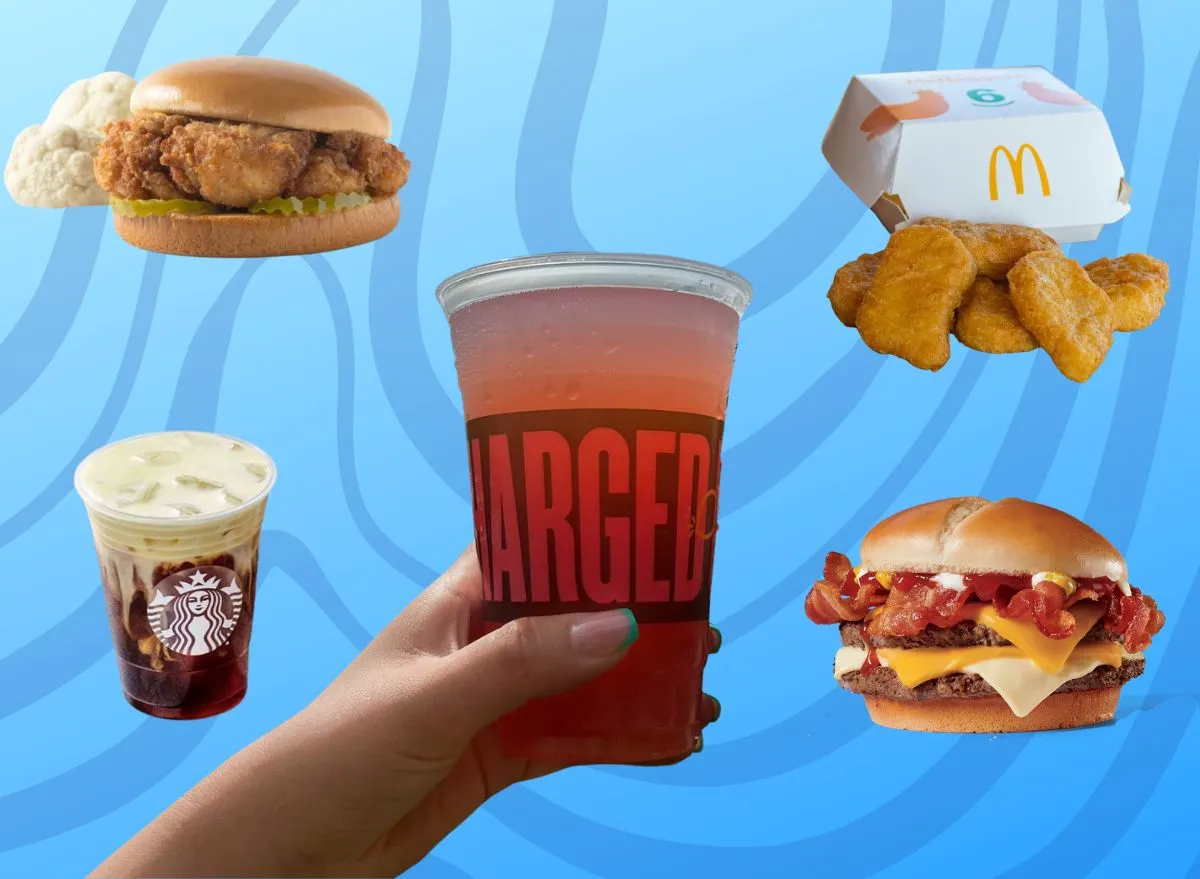
Fast food has served as a cornerstone of American society for the better part of a century. Offering an undeniably convenient combination of speed and affordability, the fast-food concept has conceived some of the largest, most lucrative, and most popular brands in the world.
The ubiquity and popularity of fast food has brought far more than record profits. Thanks in large part to generations of Americans who grew up on impromptu trips to the local drive-thru for a coveted Happy Meal, iconic fast-food burgers like the Big Mac and Whopper are just as ingrained in the fabric of American pop culture as any movie, TV show, or song.
Of course, with cultural prominence also comes increased scrutiny. The 24/7 news cycle loves a bit of controversy to help drive interest and engagement, and the world of fast food has never failed to provide eye-brow raising news stories on a habitual basis.
Many of the biggest fast-food controversies have developed over time into the stuff of urban legend. From lawsuits and whispers alleging Taco Bell’s beef is barely beef at all, to a viral image on the internet of Burger King employees with their shoes in the lettuce, there’s no shortage of controversial stories tied to fast food.
While some are flat-out false, like the popular myth that KFC once served a deep-fried rat, others are undeniably true. There’s no getting around the fact Subway had now-convicted pedophile Jared Fogle as their spokesperson for over a decade, and thanks to the internet, we’ll always remember the ill-fated marketing campaign put together by one U.K.-based Krispy Kreme called “KKK Wednesday.”
We’ve just begun to scratch the surface when it comes to fast-food controversies, and unlike the examples mentioned above, many of the most bizarre and captivating stories are tied to specific fast-food menu items and promotions. In no particular order, let’s take a look at the 25 most controversial fast-food items of all time.
McDonald’s McNuggets
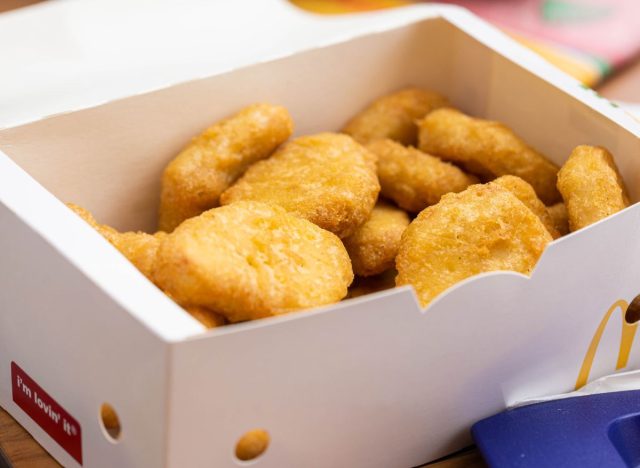
A staple of McDonald’s menu, countless customers consider Chicken McNuggets their go-to order at the Golden Arches. Still, the classic menu item has been no stranger to controversy over the years—mainly tied to what’s actually inside each crispy morsel.
Rumors had long persisted that there’s a woefully small amount of chicken within each McNugget, and the topic came under intense scrutiny around 15 years ago when an image began circulating around the internet depicting a large pile of pink goop or slime supposedly called “mechanically separated poultry” used to create McNuggets. Customers far and wide were understandably disgusted, and McDonald’s has worked diligently ever since to disavow the validity of the claim.
The mega successful chain even has a page on its website addressing the controversy. The statement reads: “No, our Chicken McNuggets do not contain what some people call ‘pink slime’ or ‘pink goop.’ We’ve seen the photo of ‘pink goop’ or ‘pink slime’ in association with McDonald’s. Let’s set the record straight: this image in connection with McDonald’s is a myth. In fact, we don’t know where it came from, but it’s not our food.”
Chick-fil-A’s Cauliflower Sandwich
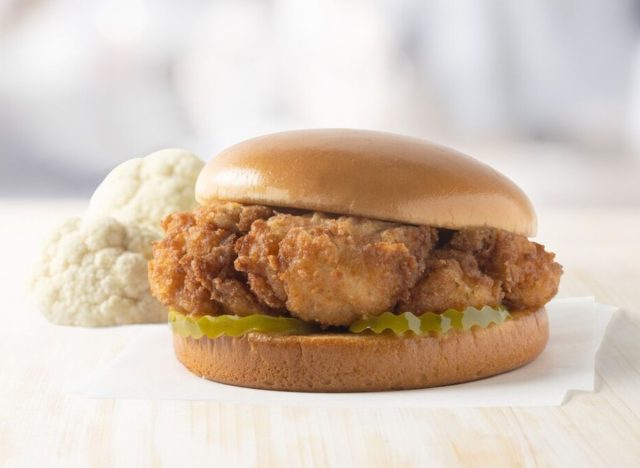
What happens when a fast food brand celebrated for its chicken offerings dives into vegetarian fare? A whole lot of complaints and controversy! Chick-fil-A rolled out the Cauliflower Sandwich for a limited time at select locations last year, immediately sparking a visceral reaction from its customer base.
While some simply bemoaned the use of a vegetable as a sandwich’s main ingredient, others took a decidedly political approach. Chick-fil-A has long been known for its Christian values; locations are closed on Sundays and the chain has donated to anti-LGBTQ organizations in the past. So, many accused the brand of bending the proverbial knee to “wokeness” with its veggie menu offering.
“Not a penny more spent on your woke agenda,” one social media user posted.
Moreover, the Cauliflower Sandwich couldn’t even be called vegetarian due to being prepared in the same kitchens as all that chicken, further infuriating many customers. Instead Chick-fil-A called the sandwich “plant-forward,” telling Eat This, Not That! that the “decision to step into the plant-forward space came directly from customer feedback asking for more variety and the opportunity to flex their diets by incorporating more vegetables into their meals.”
Starbucks’ Iced Coffee
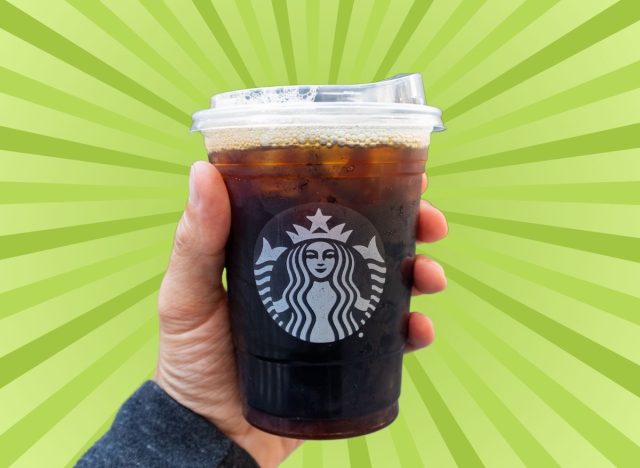
Countless people have made grabbing a refreshing iced coffee from their local Starbucks a part of their morning routine, but a series of unsettling reports in 2017 likely forced many to reconsider their iced coffee habit. The culprit? Believe it or not, feces.
That’s right, a BBC investigation at the time revealed trace amounts of fecal bacteria present in samples of Starbucks’ Iced Coffees. One doesn’t need to be a doctor to know ingesting feces has the potential to induce major gastrointestinal distress and a litany of subsequent health issues.
In all fairness to Starbucks, this is hardly an issue exclusive to the Seattle-based coffee chain. Fecal coliforms have been known to thrive within ice machines for some time now, and even the original BBC report found the same bacteria in samples taken from other coffee chains like Costa Coffee. Moreover, Live Science points out that these coliforms, while absolutely known to live within feces, are also found among many other items in nature like fruits and vegetables.
McDonald’s McLean Deluxe
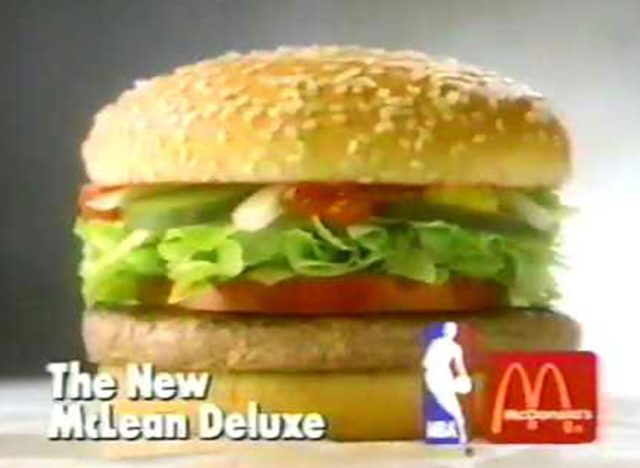
The crown jewel of McDonald’s ill-fated Deluxe line introduced in the 1990s, the McLean Deluxe was supposed to be a healthier burger intended for more sophisticated, adult patrons. Consisting of a reduced fat patty, ketchup, mustard, a whole lettuce leaf, pickles, and a sliced tomato on a bakery roll, the burger certainly had the right intentions—yet fell flat in terms of both flavor and customer satisfaction.
What went wrong? Well, the patty used for the McLean only consisted of 90% meat, with the last tenth being made up of carrageans (an organic chemical derived from seaweed). The burger was universally panned by critics and customers alike (with many calling it the “McFlopper”) for an overwhelmingly bland flavor profile, and sales steadily declined before the McLean was put out to pasture for good in 1996.
Burger King’s then-Chairman & CEO Brian Gibbons even chimed in on his competitor’s failure, reportedly stating, “Consumers have had their fill of healthier fare. They’re saying, `Thanks for the choice, thanks for the (nutrition) info. Whopper and fries, please.”
KFC’s Nail Polish

It’s common, if not expected, to finish a fast-food meal with greasy fingers. KFC took its “Finger Lickin Good” slogan to an entirely new level back in 2016 with the release of two edible nail polish flavors in Hong Kong. The two flavors, Hot & Spicy and Original Recipe, even came in packaging made to mimic high end makeup products.
Unfortunately, this promotion is a perfect example of style over substance, as the nail polish was only safe to use for five days after opening the bottle (even when refrigerated).
Moreover, the colors appeared transparent and clumpy upon application, and a taste test performed by the BBC came back lukewarm at best: “The spicy flavor tasted almost exactly like the paste used in KFC’s hot & spicy chicken. It definitely lingered on the tongue, but we couldn’t detect any fried chicken flavor.” Reviews were similar for the original recipe nail polish.
Reactions on social media and among customers who actually tried the nail polish flavors ranged widely from genuine curiosity to absolute disgust, but there’s no denying this controversial limited-time menu offer had people talking.
Subway’s Footlong
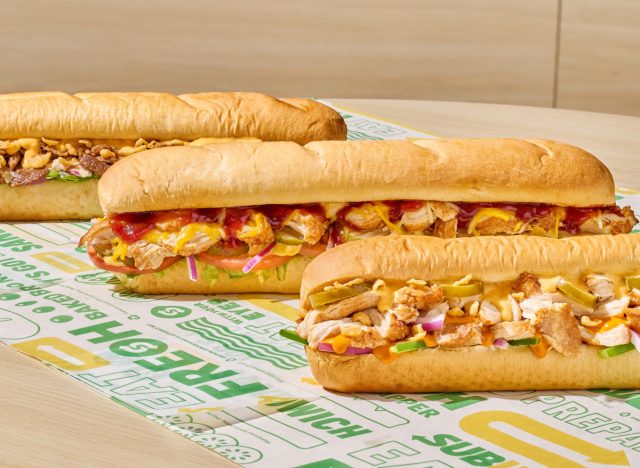
The $5 Footlong undoubtedly ranks among Subway’s most popular and well-known promotions. While the concept and accompanying marketing campaign turned out to be iconic for the sandwich chain, the Footlong also brought more than its fair share of controversy to the fast-food brand.
The trouble started back in 2013 when an Australian customer posted a picture of their Footlong. The only problem? The sandwich measured a meager 11 inches instead of the advertised 12. The image went viral and before long plenty more customers all over the world were sharing images of undersized subs.
Multiple lawsuits eventually emerged over the small sandwiches, and the issue became so prevalent that Subway released a statement to the Chicago Tribune: “We have redoubled our efforts to ensure consistency and correct length in every sandwich we serve. Our commitment remains steadfast to ensure that every Subway Footlong sandwich is 12 inches at each location worldwide.”
Burger King’s Satisfries
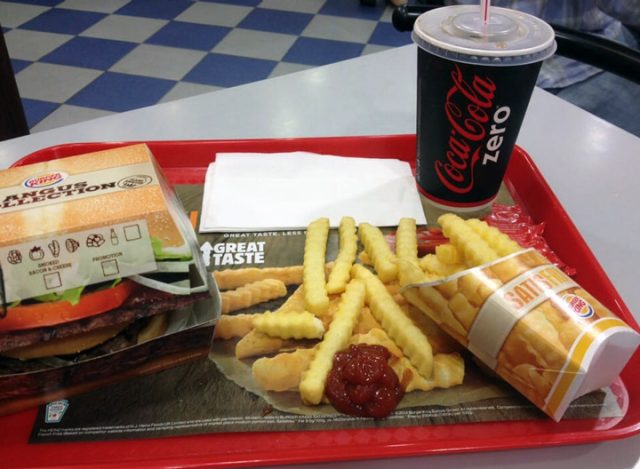
Around a decade ago, Burger King made a valiant effort to offer customers a healthier potato option with the Satisfries. Advertised as lower-fat fries, the Satisfries were prepared in a less-porous batter that supposedly promoted the absorption of less oil during frying.
While that certainly sounds healthier, the numbers (both caloric and financial) didn’t quite add up in the Satisfries’ favor. Ultimately, these fries only boasted four fewer grams of fat and 70 fewer calories than BK’s regular fries—and the Satisfries were significantly more expensive at 30 cents more per small order.
The Satisfries earned the unenviable nickname “saddest fries” among BK patrons, before the menu item was understandably done away with altogether after just one year.
McDonald’s Cardi B & Offset Meal
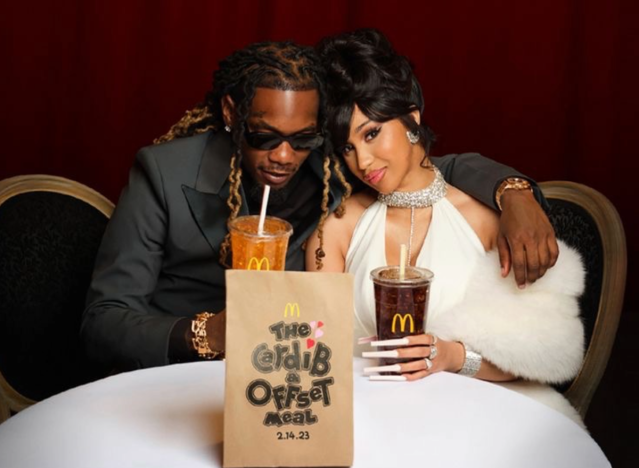
It’s become more and more common to see fast-food brands partner with celebrities for various promotions and releases, which is exactly what McDonald’s did with popular rappers Cardi B and Offset last year. Intended to serve as a meal to share among couples ahead of Valentines Day 2023, the Cardi B & Offset Meal appeared at first glance as a win-win for McDonald’s and music fans alike.
A number of McDonald’s franchisees, however, were reportedly concerned that the brand’s collaboration with the musicians violated a set of internal rules known as the “Golden Arches Code.” The operators believed the collaboration may hurt McDonald’s family-friendly brand image due to the profanities and explicit content present in much of the hip-hop couple’s music.
While McDonald’s executives defended the collaboration and emphasized the complaints were coming from just a small number of franchisees, the story is still a rare example of friction among fast-food operators making national news.
Taco Bell’s Black Jack Taco
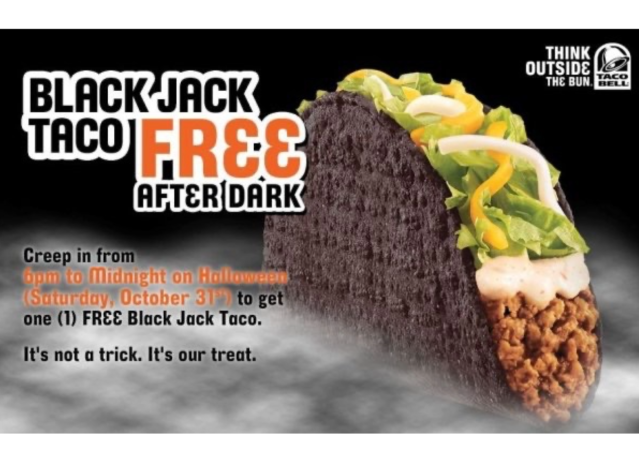
Released in 2009 for just 89 cents as a Halloween promotion, Taco Bell’s Black Jack Taco featured a black-colored taco shell filled with beef, Baja sauce, a three-cheese blend, and lettuce. The idea behind the menu item was to add a little bit of spooky fun to customers’ meals, but unfortunately the Black Jack Taco ended up giving many people a very different experience.
It didn’t take long for the internet to become abuzz with reports of the Black Jack Taco turning many customers’ bowel movements green. The menu item was discontinued shortly after that and the taco has yet to make a return.
Taste-wise, many people did enjoy the Black Jack Taco, and its potential return is still discussed today. One fan on Reddit wrote, “My poop is jet black anyways, might as well,” while discussing a possible Black Jack comeback just two years ago. Still, for many consumers, this controversial taco will always be best remembered for its unpleasant stomach side effects.
Arby’s Brown Sugar Bacon
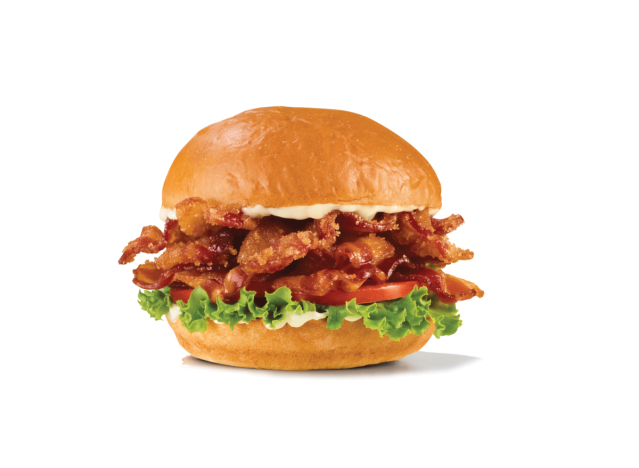
What made Arby’s Brown Sugar Bacon controversial had nothing to do with the delicious, crispy bacon itself. In a bizarre move, Arby’s launched an ad campaign for the new bacon in 2015 targeting vegetarians. Even worse, the promotional campaign more or less mocked vegans and vegetarians alike for their dietary choices and insinuated they needed “help” resisting the brand’s new bacon.
Arby’s commercials at the time encouraged vegans to call a 1-855-MEAT-HLP hotline for help with their “urges to find and devour this meat.” The hotline was indeed real, and upon calling listeners were greeted by an automated message instructing them to take a breath and eat a salad.
It’s easy to imagine how this type of campaign would infuriate countless vegetarians and vegans. At the time, Len Torine, executive director of the American Vegetarian Association, told the New York Daily News, “I sincerely doubt they’re going to sway any of the purists.”
Burger King’s A1 Halloween Whopper
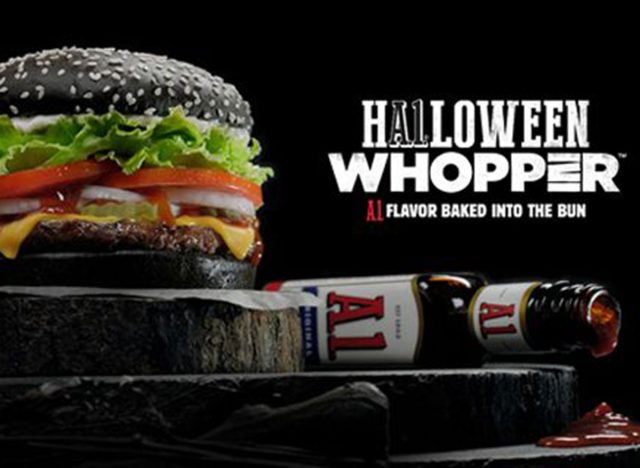
Following in Taco Bell’s questionable footsteps six years prior, Burger King launched the A1 Whopper during Halloween season in 2015. Just like the Black Jack Taco’s shell, this Whopper’s bun was black due to the dough being mixed with A1 steak sauce. While the idea sounds tasty in theory, the actual burger suffered from the same gastrointestinal consequences as its predecessor.
Social media quickly became inundated with reports of green feces following ingestion of the A1 Whopper. The hashtag #greenpoop even went viral on Twitter. While ultimately harmless, and probably quite humorous for those who ordered anything else, the colorful outcome of ordering an A1 Whopper was no laughing matter for countless customers.
“To make poop turn that color green, it would require far more dye than is in the typical type of A.1.,” Pamela Reilly of Indianapolis, a naturopathic doctor and certified nutrition counselor, told USA Today. “My guess is that they’re using a concentrated form.”
Panera Bread’s Charged Lemonade
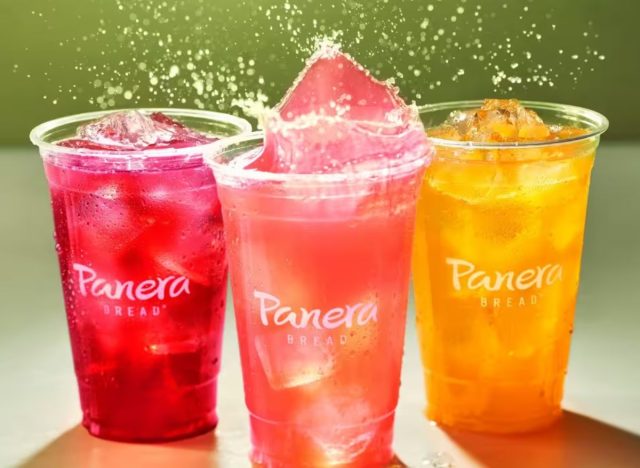
First introduced in 2022, Charged Lemonade was removed entirely from Panera menus earlier this year in the wake of three lawsuits and a pair of alleged deaths tied to the extremely caffeinated beverages.
Originally marketed as a refreshing, sweeter means of gaining some extra energy, a large-sized Charged Lemonade contained up to 236 milligrams of caffeine. For reference, a single 8.4 oz can of Red Bull includes 80 milligrams of caffeine. Per the FDA, a healthy adult can usually consume up to 400 mg of caffeine on a daily basis.
At the heart of the controversy and lawsuits surrounding Charged Lemonade is the sentiment that many customers felt they had not been properly informed that they were ordering such a stimulating beverage. One of the lawsuits was filed by a woman who had no underlying health conditions before consuming two and a half Charged Lemonades over the course of one day. Now, she reportedly deals with irregularly fast heart palpitations and takes regular medication to regulate her heartbeat.
“The primary reason she ordered this drink was because it was advertised as ‘plant-based’ and ‘clean,’” the complaint reads, per CNN. “This marketing is especially dangerous to a vulnerable population, children and adults who would reasonably believe this product was lemonade and safe for consumption.”
McDonald’s McAfrika
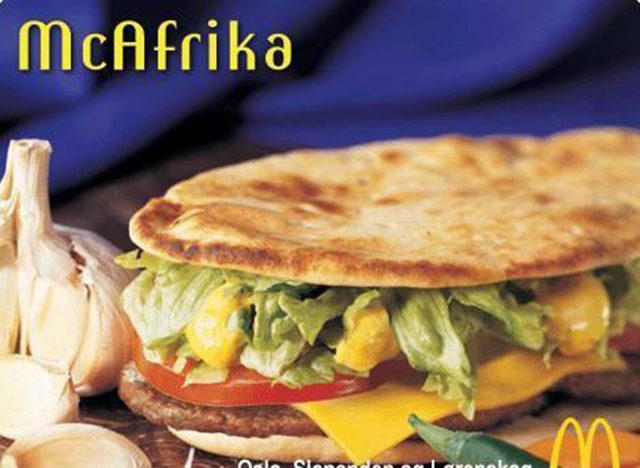
Even the name of the long-gone McAfrika from McDonald’s is enough to elicit a cringe from many readers. Released in 2002 as a promotion for the Olympic Games, the McAfrika was supposedly based on an “authentic” African recipe featuring pita bread instead of a bun.
Well, at that time, there was a very real famine taking place in parts of Southern Africa such as Zimbabwe and Malawi. The backlash was immediate and understandable, especially considering the McAfrika was exclusively released in one of the world’s wealthiest nations (Norway) while millions in Africa struggled to find any food at all.
Not all responses were negative: The African Youth in Norway organization argued the McAfrika represented a positive piece of African culture amid tough times. Still, the controversial legacy of this menu item is undeniable.
Long John Silver’s Big Catch Meal
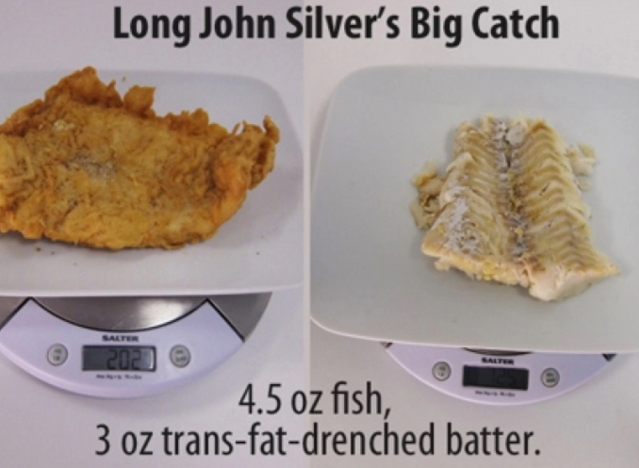
The Big Catch Meal, released by seafood chain Long John Silver’s in 2013, will forever live in infamy for being named the “Worst Restaurant Meal in America” by the Center for Science in the Public Interest. What made this menu item so much worse than other contenders? A whopping 33 grams of trans fat, 19 grams of saturated fat, and close to 3,700 mg of sodium, just to name a few reasons.
The concept behind the meal was well-intentioned, at least. Why not offer customers a little bit of everything in one meal? The Big Catch Meal featured a 7.5 ounce deep fried fish, hush puppies, and onion rings.
“Long John Silver’s Big Catch meal deserves to be buried 20,000 leagues under the sea,” CSPI executive director Michael F. Jacobson commented at the time. “This company is taking perfectly healthy fish—and entombing it in a thick crust of batter and partially hydrogenated oil. The result? A heart attack on a hook. Instead of the Big Catch, I’d call it America’s Deadliest Catch.”
The response to the Big Catch Meal was so convincing Long John Silver’s quickly removed the meal from menus and even pledged to transition to trans-fat free cooking oils.
Starbucks’ Oleato Coffee
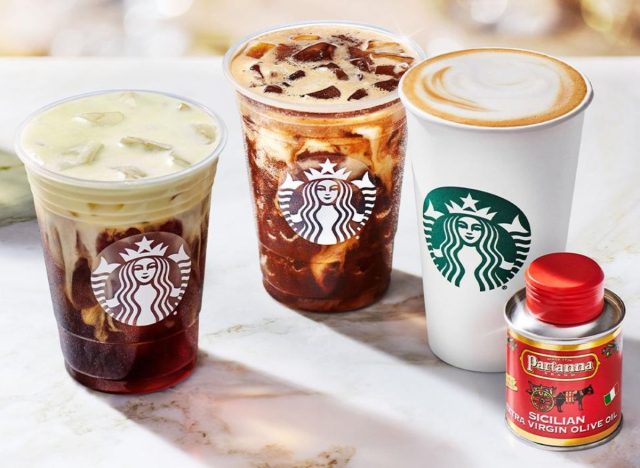
Following a limited release last year across both domestic and international locations, Starbucks rolled out its Oleato Coffee line nationwide earlier this year. Coffee infused with award-winning Partanna extra-virgin olive oil, the beverages proved divisive among Starbucks patrons almost immediately. After all, is olive oil in coffee really a good idea?
While some posit the drinks are delicious, others say they result in frequent trips to the bathroom—even going so far as to call them “legit laxatives.” One self-described Starbucks employee even suggested on Reddit that multiple coworkers had to use the bathroom after sampling the new beverages.
Calling the Oleato drinks laxatives may sound like hyperbole, but it probably isn’t all that far off, at least for certain stomachs. A registered dietician told Eat This, Not That! olive oil can indeed induce a laxative effect in some people, especially when combined with caffeine.
McDonald’s Hula Burger
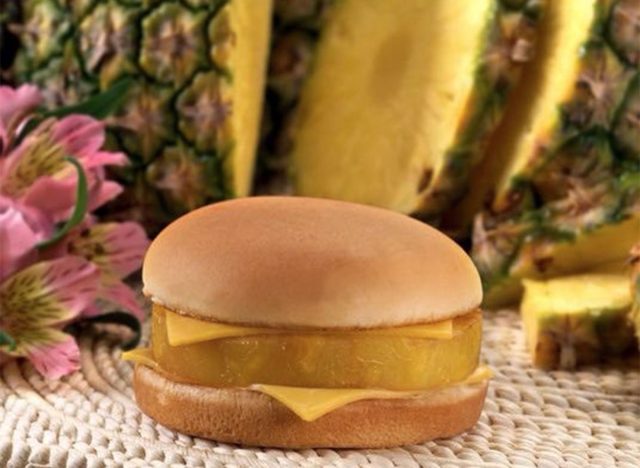
Another bizarre entry in McDonald’s long history of failed menu experiments, the Hula Burger was a brainchild of legendary McDonald’s pioneer Roy Croc himself back in the early 1960s. Put together with Lent-observing Catholics in mind, the Hula Burger was made up of nothing more than a bun, cheese, and a slice of grilled pineapple.
Intended to compete with the Filet-O-Fish, which was invented around the same time by a McDonald’s franchisee in Ohio named Lou Groen, the Hula Burger flopped in a major way when pitted against its fishy rival. Croc even made a bet with Groen that if the Filet-O-Fish outsold the Hula Burger, he would make the Filet-O-Fish a permanent part of the menu.
It isn’t hard to tell which sandwich won that contest. Today, the Filet-O-Fish remains a menu staple while the Hula Burger is nothing more than an amusing fast-food footnote.
Jack in the Box’s Frings
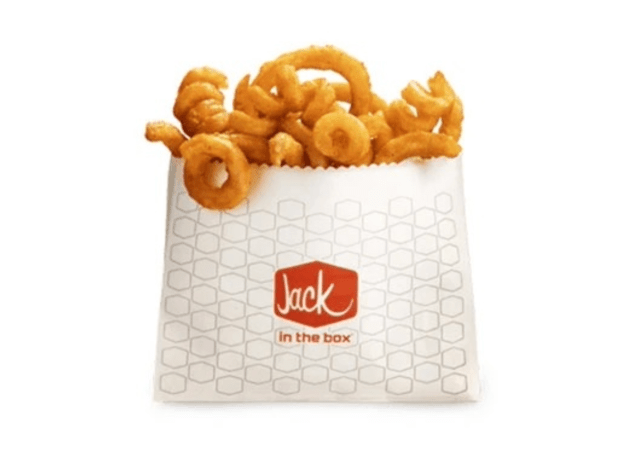
Conceived as a combination of fries and onion rings, Jack in the Box’s Frings were an idea that sounded pretty darn good on paper yet failed miserably upon execution. Released in 1979, the West Coast fast-food chain was certain they had a hit on their hands. But what exactly were Frings? As the name implies, Frings were simply fries and onion rings served together in the same bag.
Considered one of the biggest fast-food failures of the 1970s, Frings were long gone by the mid-1980s. While their legacy lives on as something of a cult favorite among fast-food historians, Jack in the Box maintains its unlikely you’ll ever see them reappear on the menu, stating that the frings have “gone the way of mood rings and shag carpeting.”
McDonald’s Fries
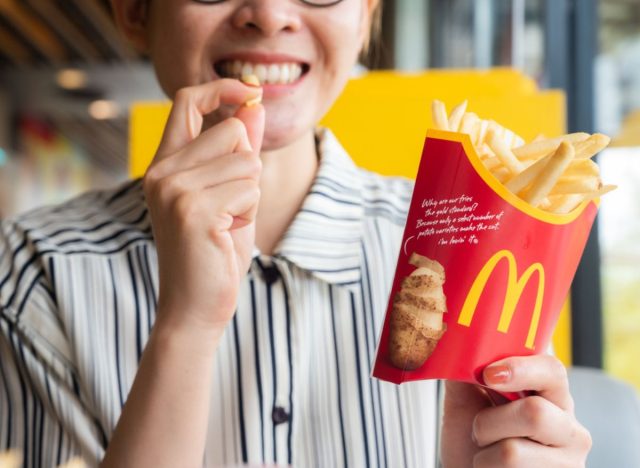
Perhaps the quintessential fast-food item, McDonald’s perfectly crispy, crunchy fries are irresistible to countless customers. This iconic menu item, however, is no stranger to controversy. While the Golden Arches publicly acknowledged cooking its fries in animal fat throughout the 1980s, the chain switched to vegetable oil in 1990.
The change initially thrilled vegetarians and vegans, but everyone else wasn’t so happy. McDonald’s stock reportedly dropped by over 8% after announcing the change. The problem? The new fries just didn’t taste the same, so Mickey D’s began adding “natural beef flavoring” to its prep process in order to reclaim the spud flavor customers had come to expect.
Multiple vegetarians ended up suing McDonald’s in the early 2000s over the fries recipe, claiming they had been misled into consuming a food item that wasn’t truly meat-free. Even today, according to TreeHugger, McDonald’s fries remain tinged with hints of beef flavoring.
McDonald’s Szechuan Sauce
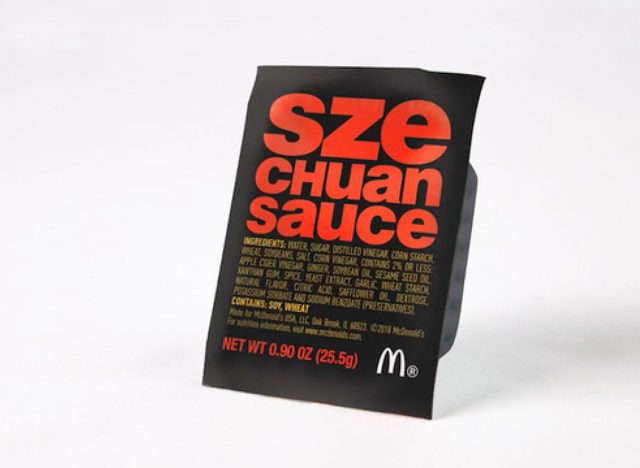
The story of McDonald’s Szechuan Sauce serves as a poignant reminder of the power of pop culture. First released in 1998 as a promotional collaboration with Disney for the movie “Mulan,” the Szechuan Sauce received a flurry of backlash and criticism almost immediately. Citing images of Ronald McDonald wearing a headband and performing karate, Entertainment Weekly called the sauce and accompanying promotional efforts “ethnic stereotyping.”
The Szechuan Sauce was discontinued quickly following its original release. Surprisingly, however, that wasn’t the end of the story. When popular animated TV show “Rick and Morty” featured Szechuan Sauce in a 2017 episode, an organic groundswell of demand suddenly emerged for the previously long-forgotten sauce.
McDonald’s, predictably, was quick to take advantage of the viral trend. The Szechuan Sauce was re-released that same year, but the burger chain grossly underestimated demand levels, leading to tons of frustrated customers. Locations in Florida and California even had to get the police involved over mobs of angry patrons peeved at the lack of Szechuan Sauce.
Burger King’s Super Seven Incher
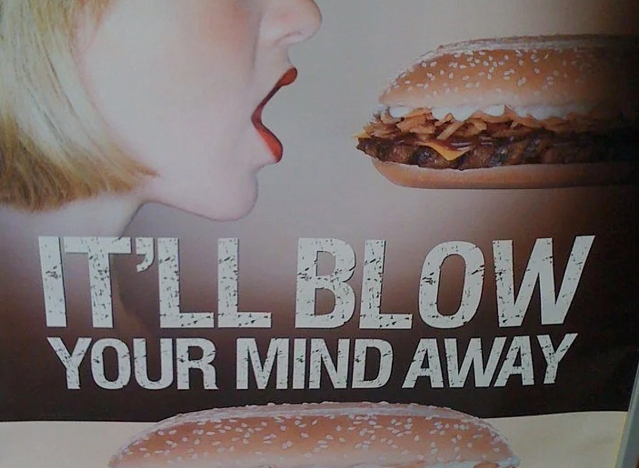
Burger King’s Super Seven Incher may have been a perfectly fine sandwich, but what made this menu item so controversial was the marketing campaign launched in support of it. Released in Singapore in 2009, the ads are anything but subtle and overtly sexual.
Text including “It Just Tastes Better” and “It’ll blow your mind away. Fill your desire for something long, juicy and flame-grilled with the New BK Super Seven Incher” is accompanied by an image of a woman with her mouth open and the sandwich hovering in front of her.
The allusions to oral sex are obvious and undeniable, which makes the campaign’s placement in the traditionally conservative nation of Singapore even stranger. BK claimed the ads were never intended to be seen by American eyes, but does that really change anything? Making matters worse, the model whose image was used in the ads called for a BK boycott in 2014, claiming she was never informed her image would be used for such adult imagery.
McDonald’s McDLT
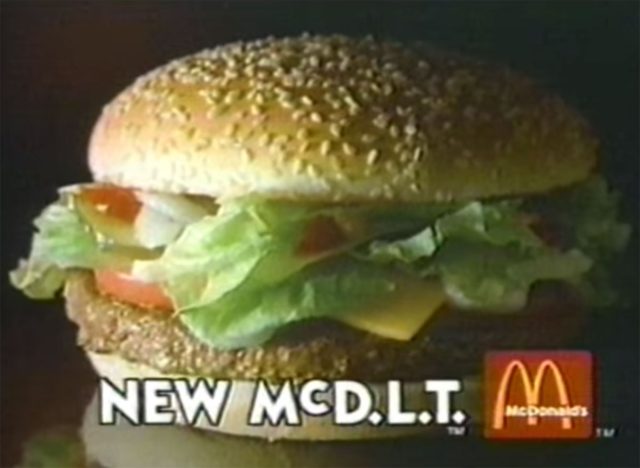
A fast-food menu item that only could have been conceived in the 1980s, McDonald’s McDLT definitely isn’t lacking in the innovation department. Alas, the big ideas behind the McDLT just didn’t quite add up in reality. The actual ingredients involved in the McDLT were quite simple; nothing more than a burger, bun, lettuce, and tomato.
Here’s the catch: the meal was served in a styrofoam container that separated the meat and vegetables. The selling point was that the separation would keep the burger patty hot and the toppings cold, while also allowing customers the fun of building their own burger. Not a half bad idea, but most of the time patrons just ended up being served a lukewarm, half-put-together burger.
The McDLT also came under intense scrutiny due to all the environmentally harmful plastic needed to produce the menu item. The burger was discontinued in 1990, but we’ll always have the super campy dancing commercials (featuring a young Jason Alexander long before his star turn on TV’s “Seinfeld”) to remember this remnant of fast food’s past.
A&W’s 1/3 Pound Burger
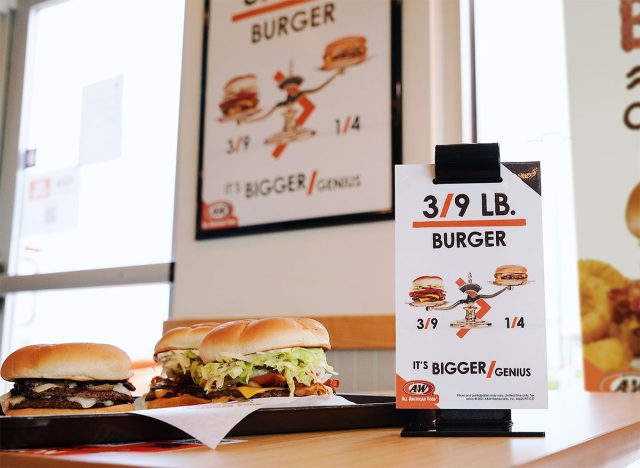
In a bid to challenge the dominance of McDonald’s Quarter Pounder, the fast-food chain A&W released its own numerically themed menu item in the 1980s with the Third Pound Burger. Naturally, A&W opted to make its version even larger while retaining the same price point, in the hopes that customers would go for the bigger meal.
Oddly enough, that didn’t happen. Then-A&W owner A. Alfred Taubman recalled in his book “Threshold Resistance” that “we were aggressively marketing a one-third-pound hamburger for the same price…but despite our best efforts, including first-rate TV and radio promotional spots, they just weren’t selling.”
After bringing in a market research group to help diagnose the issue, A&W finally discovered what was stopping customers from trying the Third Pound Burger. A large percentage of the public incorrectly believe a third of a pound is actually less than a quarter of a pound, thus leading to the false assumption McDonald’s Quarter Pounder contained more food.
The Third Pound Burger has since been re-released as the 3/9 Pound Burger, but the original version will forever live in infamy for apparently asking people to perform just a little too much math in their heads before ordering at the drive-thru.
Jack in the Box’s Teriyaki Bowls
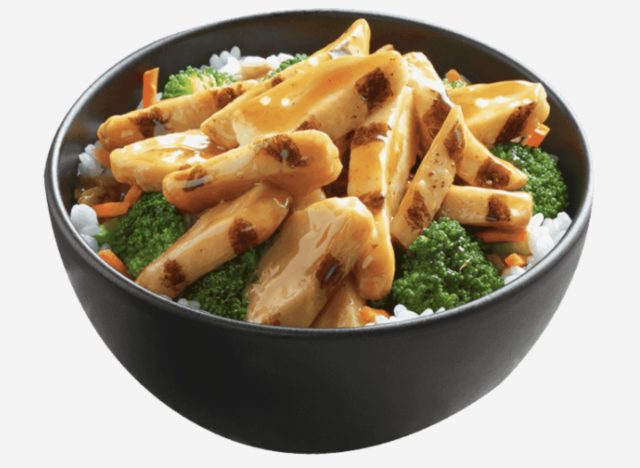
Another victim of a poorly thought out marketing idea and even more unfortunate timing, Jack in the Box’s Teriyaki Bowls were released in 2018 in conjunction with a series of “Try My Bowls” commercials released by the fast-food chain. The ads make light of how similar “bowls” and “balls” sound. For instance, in one ad, the Jack in the Box mascot tells a worker they have “pretty nice bowls,” while another adds “everyone is going to want to get their hand on Jack’s bowls.”
The implication is hardly subtle, and while the commercials do attempt to add a wink and a nod to the campaign by ending with an executive telling the mascot “you can’t say that,” the entire effort stills comes across as crass and low brow.
The timing of the campaign certainly didn’t help either. The ads were released at the height of the #MeToo movement.
McDonald’s Coffee
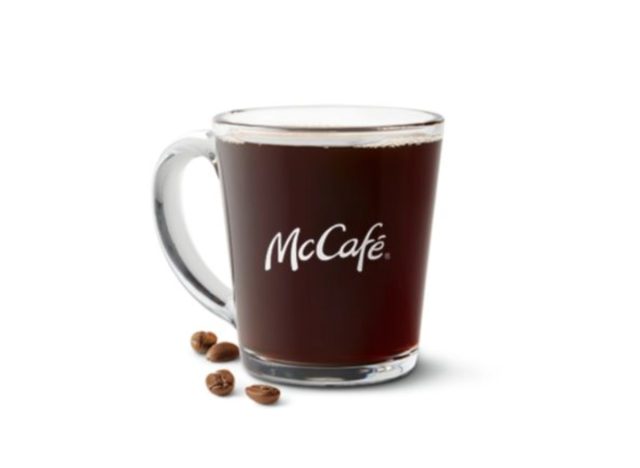
The lawsuit filed against McDonald’s in the early ’90s over its scorching hot coffee is probably one of, if not the most, well-known fast-food controversies to date. The short version states a woman filed a lawsuit against the Golden Arches after extremely hot coffee was spilled on her lap. Many people hear this version and scoff at how quickly Americans turn to litigation, but the real story is far more complex.
Stella Liebeck, the woman who filed the lawsuit, wasn’t just looking for a quick payday. To start, the third-degree burns she reportedly suffered from the 190-degree beverage were incredibly severe and kept her in the hospital for weeks. Initially, Ms. Liebeck only asked McDonald’s to cover her hospital bills (roughly $20,000). Well, Mickey D’s initially balked at that request, instead offering a mere $800.
It was only after these developments that the near $3 million lawsuit was filed—a case that Ms. Liebeck ultimately won. It’s also important to note that McDonald’s was well aware its coffee was being served at ridiculously high temperatures. The fast food chain had already received at least 700 complaints about its hot coffee temperatures prior to the incident involving Ms. Liebeck.
Jack in the Box’s Monster Burger
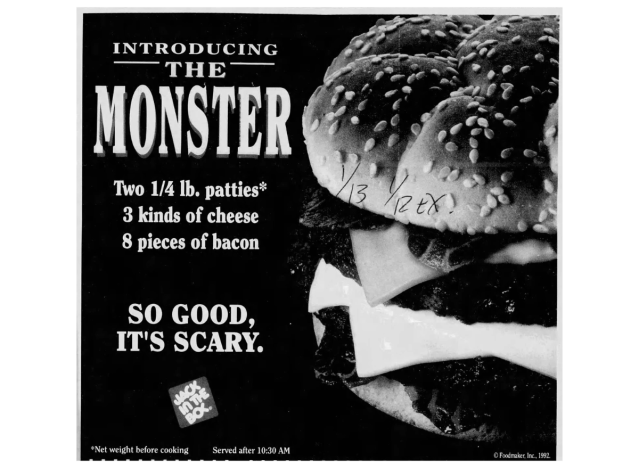
Jack in the Box’s Monster Burger included two quarter-pound beef patties, three slices of cheese, and eight slices of bacon when it debuted in January 1993. Driven by discounts and the slogan “So Good It’s Scary!” the Monster Burger enjoyed incredible popularity upon release.
Now, usually high demand is a problem that any restaurant chain would like to have, but all the customers ordering Monster Burgers reportedly “overwhelmed” numerous Jack in the Box locations, leading to many beef patties being served undercooked. While that would certainly be bad enough under normal circumstances, many West Coast locations had been shipped beef contaminated with E. coli.
The ensuing E. coli outbreak caused by the undercooked Monster Burgers was one of the worst ever in U.S. history. Over 700 people became sick, 171 were hospitalized, and 4 children passed away. All in all, 73 Jack in the Box locations were implicated in the outbreak.
The effects of this outbreak are still felt today. At the time, U.S. President Bill Clinton pledged to improve food safety standards, and the incident was described in 2006 by a U.S. Senator as a “a pivotal moment in the history of the beef industry.”
Understandably, it took a long time before Jack in the Box was able to repair its public image. Surprisingly, however, the Monster Burger is still available today albeit under a different name: The Bacon Ultimate Cheeseburger.